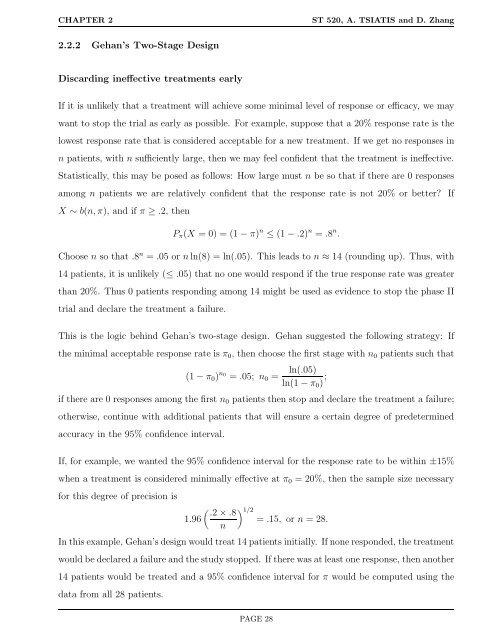ST 520 Statistical Principles of Clinical Trials - NCSU Statistics ...
ST 520 Statistical Principles of Clinical Trials - NCSU Statistics ...
ST 520 Statistical Principles of Clinical Trials - NCSU Statistics ...
You also want an ePaper? Increase the reach of your titles
YUMPU automatically turns print PDFs into web optimized ePapers that Google loves.
CHAPTER 2 <strong>ST</strong> <strong>520</strong>, A. TSIATIS and D. Zhang<br />
2.2.2 Gehan’s Two-Stage Design<br />
Discarding ineffective treatments early<br />
If it is unlikely that a treatment will achieve some minimal level <strong>of</strong> response or efficacy, we may<br />
want to stop the trial as early as possible. For example, suppose that a 20% response rate is the<br />
lowest response rate that is considered acceptable for a new treatment. If we get no responses in<br />
n patients, with n sufficiently large, then we may feel confident that the treatment is ineffective.<br />
<strong>Statistical</strong>ly, this may be posed as follows: How large must n be so that if there are 0 responses<br />
among n patients we are relatively confident that the response rate is not 20% or better? If<br />
X ∼ b(n, π), and if π ≥ .2, then<br />
Pπ(X = 0) = (1 − π) n ≤ (1 − .2) n = .8 n .<br />
Choose n so that .8 n = .05 or n ln(8) = ln(.05). This leads to n ≈ 14 (rounding up). Thus, with<br />
14 patients, it is unlikely (≤ .05) that no one would respond if the true response rate was greater<br />
than 20%. Thus 0 patients responding among 14 might be used as evidence to stop the phase II<br />
trial and declare the treatment a failure.<br />
This is the logic behind Gehan’s two-stage design. Gehan suggested the following strategy: If<br />
the minimal acceptable response rate is π0, then choose the first stage with n0 patients such that<br />
(1 − π0) n0 = .05; n0 = ln(.05)<br />
ln(1 − π0) ;<br />
if there are 0 responses among the first n0 patients then stop and declare the treatment a failure;<br />
otherwise, continue with additional patients that will ensure a certain degree <strong>of</strong> predetermined<br />
accuracy in the 95% confidence interval.<br />
If, for example, we wanted the 95% confidence interval for the response rate to be within ±15%<br />
when a treatment is considered minimally effective at π0 = 20%, then the sample size necessary<br />
for this degree <strong>of</strong> precision is<br />
�<br />
.2 × .8<br />
1.96<br />
n<br />
�1/2<br />
= .15, or n = 28.<br />
In this example, Gehan’s design would treat 14 patients initially. If none responded, the treatment<br />
would be declared a failure and the study stopped. If there was at least one response, then another<br />
14 patients would be treated and a 95% confidence interval for π would be computed using the<br />
data from all 28 patients.<br />
PAGE 28
















